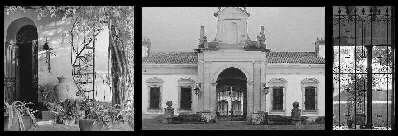Peer Voss
pvoss@pvoss.de
Estancias in Uruguay
A brief introduction to architecture and historyEin wenig Historisches und Stilkunde
Historic Estancias are a hobby of mine. By profession I am realtor for farmland properties for sale in Uruguay, but this site is rather for our edification
Historische Estancias sind ein privates Interessensfeld von mir, beruflich bin ich Makler für Farmland Immobilien in Uruguay, diese Seite soll aber der Erbauung dienen
photos Uruguay main
photos Uruguay summer
photos Uruguay winter
photos abandoned estancias
photos Estancia San Eugenio
For the Aficionado :
.
Uruguay Historic Estates, Estancias for sale

233) historic estancia on 738 hectare, grain + cattle production, US$5.900.000


Die frühen Estancias
1800 – 1870
During spanish colonial times until about 1830, Uruguay's interior remained sparsely populated, and very few buildings remain from that time. The succeeding decades were characterised by civil wars and general lawlessness in the country's interior. The economy remained little developed
Cattle and Gauchos still roamed free. The Gaucho myth, proud, freedom loving, and quick with his knife originates from that era.
Estancias of that period are massive, simple, often fortress-like structures, with thick field stone walls.
Typically Spanish colonial , they have heavy iron, sometimes wrought iron window grills, iron bars at times even protecting the gallery, floor to ceiling.
Usually the buildings form a court yard, with the cistern (aljibe) in the centre.
Die Zeit der spanischen Kolonialherrschaft bis ca 1830 hinterliess wenig Zeugnisse im Landesinneren, das Land war und blieb sehr dünn besiedelt. Die darauf folgenden Jahrzehnte waren geprägt von sporadischen Bürgerkriegen und Gesetzlosigkeit, die Wirtschaft blieb vergleichsweise gering entwickelt.
Estancias aus dieser Zeit sind einfache, massive, oft festungsartige Bauten,
mit dicken Mauern aus Feldstein. Die noch kleinen Fenster haben typisch kolonial-spanisch schwere, zT noch hand-geschmiedete Eisengitter,
manchmal sogar eine vergitterte Galerie.
Die Vieherden und die Gauchos streiften noch frei durchs Land.
Der Mythos des Gauchos, stolz, niemandes Knecht, schnell mit dem Messer zur Hand, stammt aus dieser Zeit.
Oft formen die Gebäude einen Innenhof, in dessen Mitte sich der Schöpfbrunnen der Zisterne (Aljibe) befindet.
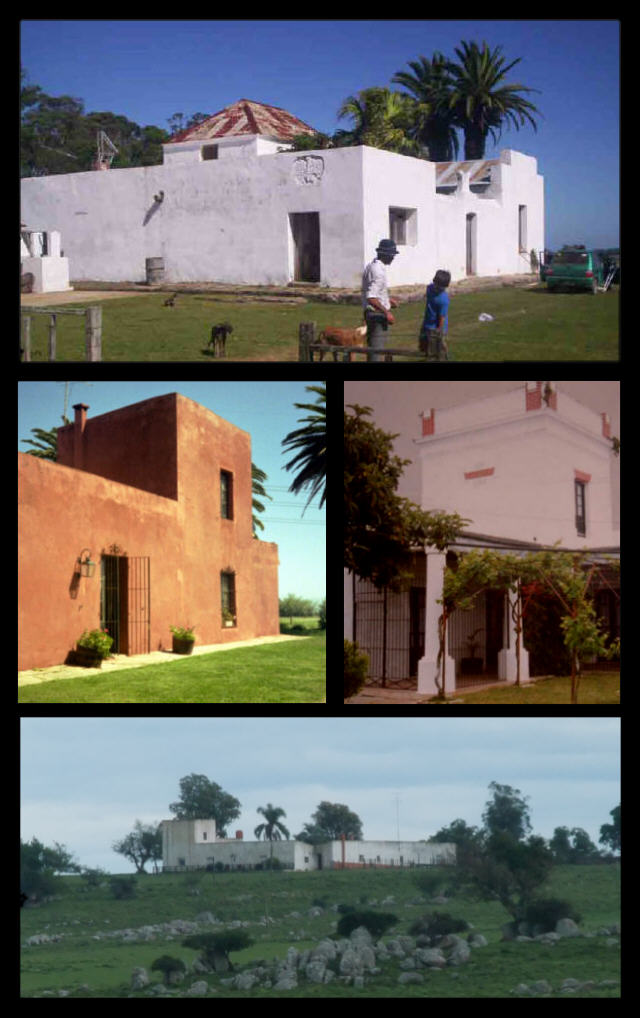
from top, from left :
a. El Altillo, built around 1800, Fraile Muerto, Cerro Largo
b. roughly 1850s, Carreta Quemada area, San José
c. Ea Martin Aquino, 1850s, said to have belonged to the famous local brigand of that time, Chamizo area, southern Florida
d. Estancia, seen on Ruta 7, central interior
klassisch ("kolonial")
1870 – 1920
Starting from the 1870s, Uruguay, similar to Argentina, became one of the most prosperous countries in the world.
Due to the advance of world trade, steam ships on the seas, railway lines in the interior, modern agriculture, introduction of European sheep
and cattle races, Uruguayan beef, wool and grain were being exported to Europe in ever larger quantities.
More European immigrants settled in Uruguay, foreign capital and technology arrived as well.
The estancieros got rich, the estancias became grand and stately.
The classic grand Casco (mansion/farmstead) Estancia of that period retains the traditional structure, forming a courtyard, the occasional mirador (tower/outlook) now serving more representation then defence purposes
Building is done by brick, rather than field stone, steel girders are used. Interior rooms are bigger, so are windows.
Stucco ornaments are richer than before.
Ab den 1870er Jahren erlebte Uruguay einen bedeutenden wirtschaftlichen Aufschwung, paralel zur Industrialisierung Europas und der beginnenden frühen Globalisierung.
Dampfschifffahrt auf den Meeren, Eisenbahnen im Inneren, moderne Produktionsmethoden, bessere Nutztierrassen :
Der Export von immer mehr Rindfleisch, Wolle, Getreide nach Europa machen Uruguay, ähnlich wie Argentinien, zu einem der reichsten Länder der Welt. Emigranten und ausländisches Kapital und Fachwissen kommen vermehrt ins Land.
Die Estancieros werden reich, die Estancias prachtvoller.
Der klassische herrschaftliche Casco (Gutshaus/Hofstelle) Estancia dieser Zeit behält die ursprüngliche oben beschriebene Grundstruktur bei, einen Innenhof formend, der manchmal anzutreffende Turm (Mirador) nun weniger der Verteidigung dienend und mehr der Repräsentation. Die Decken sind höher, gleichfalls die Fenster, die Fassaden reicher an Stuckornament, gebaut wird mit Ziegelstein und Eisenträgern.
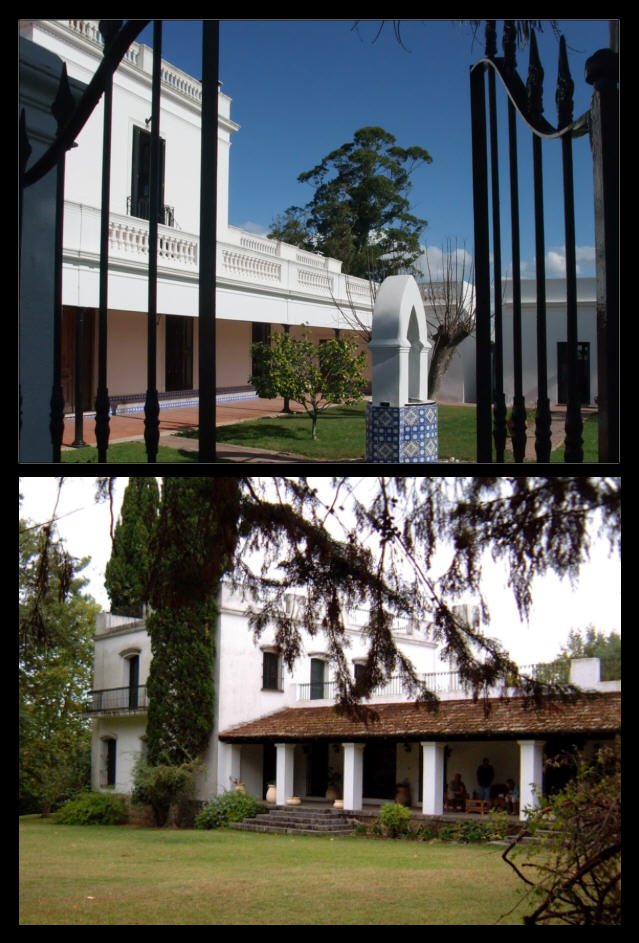
from top :
a. San Eugenio, built in the 1880s, Casupá area, southern Florida
b. Parada Arteaga, built in the 1920s, Parada Arteaga, Florida
global westlich ("ingles")
1890 – 1940
During that same period of economic growth that lasted up to the mid 20th century, more and more foreign architectural styles were introduced, similiar to stately ranch and plantation homes throughout the colonial European and anglo-american world of those times, hence also referred to as "estilo ingles" (english) as opposed to "colonial" (latin traditional)
On rule of thumb – if it forms no traditional courtyard, it might be “Estilo Ingles”
In jener o.g. Periode des Wohlstandes, die bis zur Mitte des 20ten Jahrhunderts währte, wurden ab ca 1900 mehr und mehr in importierten Architekturstilen gebaut, wie sie ähnlich bei Ranchern und Plantagenbesitzern in der kolonial-europäischen und angelsächsischen Welt jener Zeit zu finden sind, manchmal als "estilo ingles" (englisch) bezeichnet, als Gegensatz zum traditionelleren lateinischen Stil "colonial" der meist einen Innenhof, Patio formt
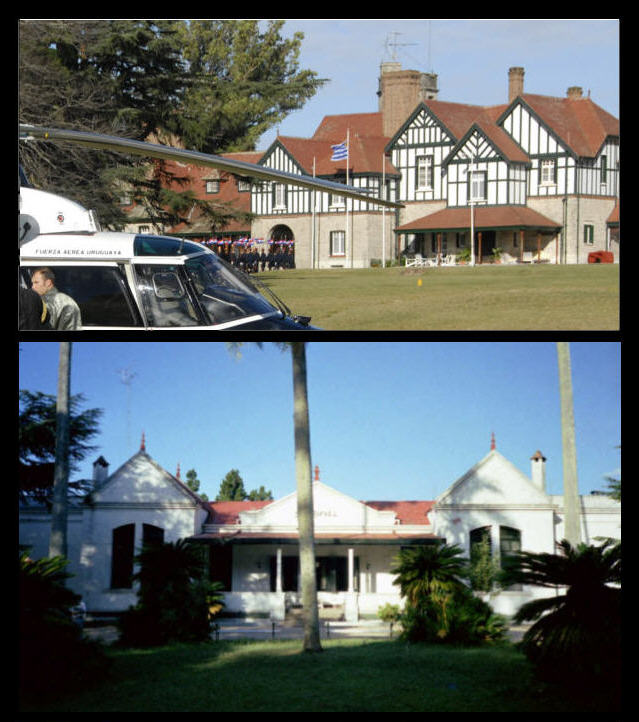
from top :
a. Ea Anchorena, the President of Uruguay's official rural residence, built around 1900, on Rio San Juan, southern Colonia
b. Ea San Rafael, built around 1900, Cordona, Soriano
neokolonial
1900 – 1940
As in other parts of the world at the turn of the century, revival architecture was present in Uruguay at the time, often in the form of spanish-colonial- or Spanish-Andalucian-revival.
Wie anderswo in der Welt der Jahrhundertwende waren auch in Uruguay historisierende Baustile in Mode, hier oft neo-spanisch-andalusisch oder neo-spanisch-kolonial
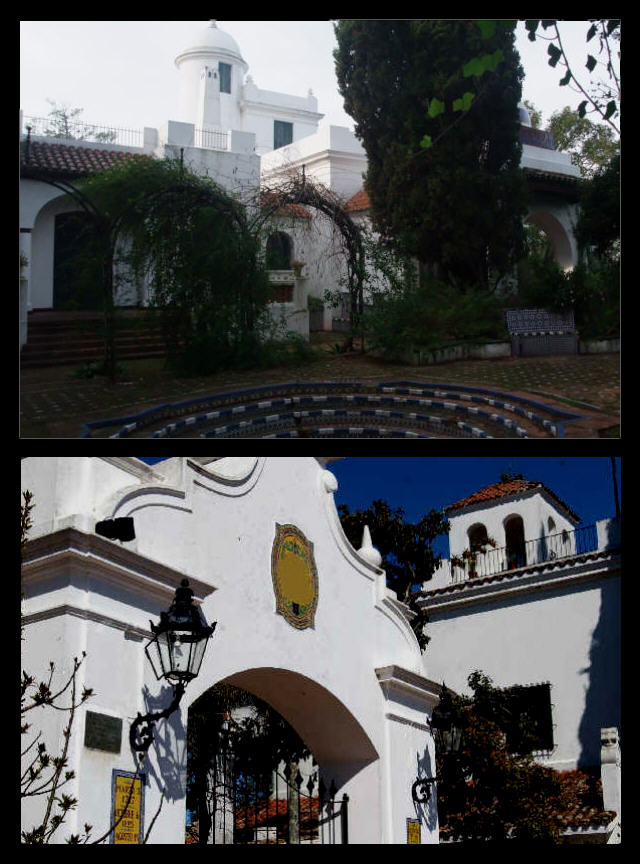 from top :
from top :Ea Taranco, built 1930, Montevideo
Ea San Pedro de Timote (currently a hotel), built in the 1920s, Cerro Colorado area, Florida
20tes Jahrhundert Moderne
1930 – 1960
The last period of prosperity lasted until roughly 1955 with the world being at war, and demand for Uruguay commodities like grain, meat and wool being strong.
The photo on the right shows a typical casco of that era.
Die letzte Periode des Wohlstands im 20.Jahrhundert durchlebte Uruguay in der Zeit bis 1955, bedingt durch den 2.Weltkrieg
und später noch ein letztes mal durch den Korea Krieg erzielten Uruguays Produkte Getreide, Fleisch, Wolle hohe Preise.
Das Foto rechts zeigt einen typischen Casco dieser Epoche.
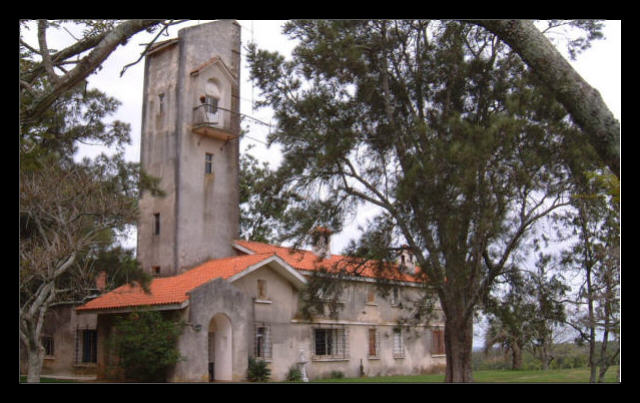
Estancia seen on Ruta 108, Lavalleja
